
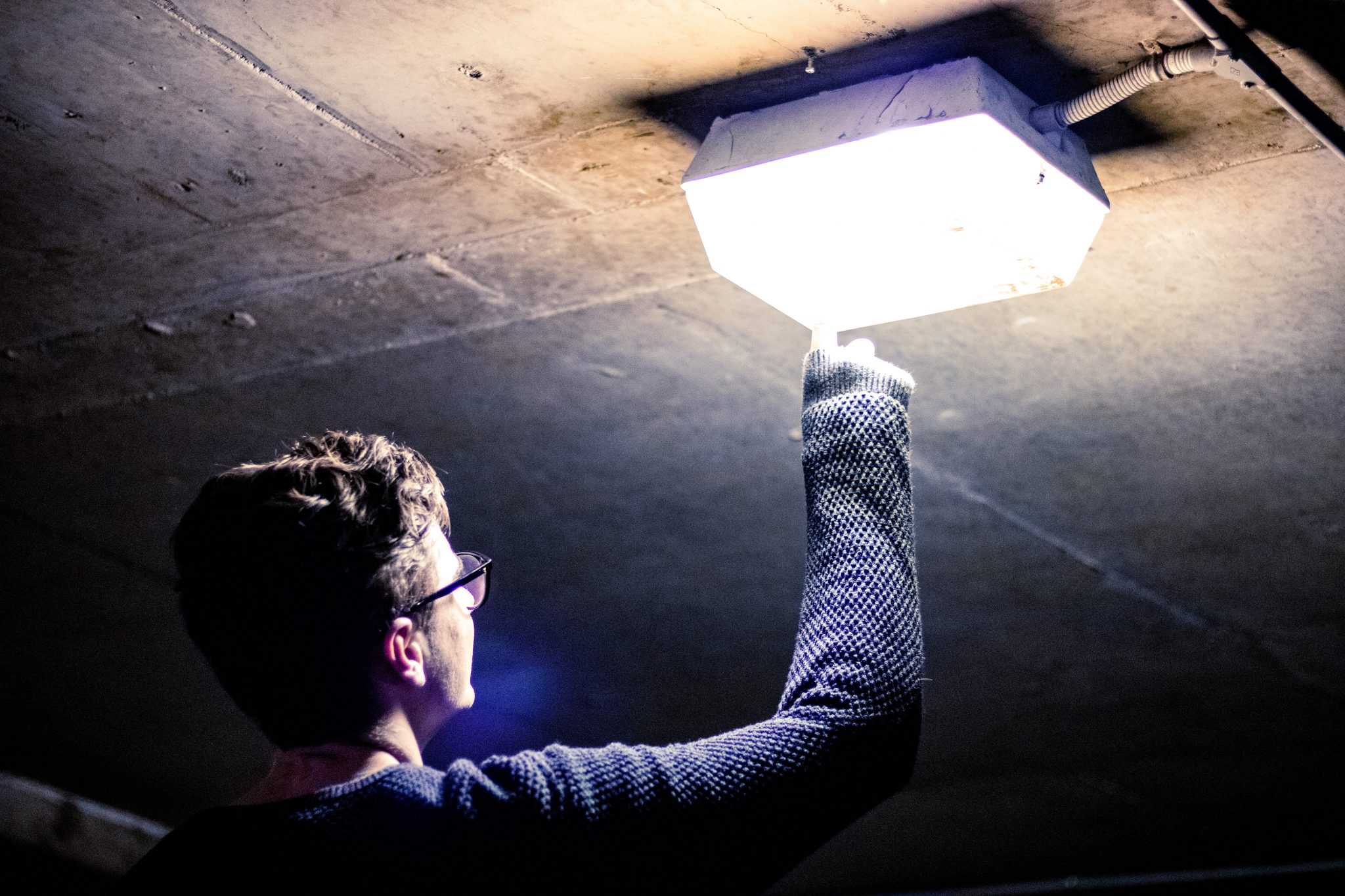
Don’t get left in the dark. Brighten up your workspace with the best garage lighting setups we could find. The search for perfect lighting ends here.
 EShine 3 12 inch Panels LED
Under Cabinet Lighting, with IR Sensor! Hand Wave Activated - Bright, Strong and Stable - Easy to Install, Screw and 3M Sticker Options Included - Deluxe Kit, Warm White
EShine 3 12 inch Panels LED
Under Cabinet Lighting, with IR Sensor! Hand Wave Activated - Bright, Strong and Stable - Easy to Install, Screw and 3M Sticker Options Included - Deluxe Kit, Warm White
Very efficient, with over 200 lumens per watt
The infrared sensor commands efficiency
Not dimmable
Small in size
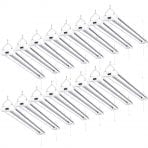 Sunco Lighting 16 PACK
ENERGY STAR ETL 4ft 40W LED Utility Shop Light 4000lm 120W Equivalent, Double Integrated LED Fixture, 5000K Daylight Ceiling Light, Garage/Basement/Workshop, Linkable, Frosted
Sunco Lighting 16 PACK
ENERGY STAR ETL 4ft 40W LED Utility Shop Light 4000lm 120W Equivalent, Double Integrated LED Fixture, 5000K Daylight Ceiling Light, Garage/Basement/Workshop, Linkable, Frosted
A great lumens/watt rate (100)
Quality LED Technology
Quite unclear setting-up manual
False advertising, saying the lamps support flush mounting when they don’t.
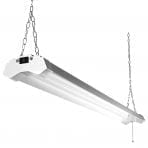 Linkable LED Utility Shop Light
4ft 4800 Lumens Super Bright 40W 5000K Daylight ETL Certified LED Garage Lights Fixture Durable LED Fixture with Pull Chain Mounting and Daisy Chain Hardware Included
Linkable LED Utility Shop Light
4ft 4800 Lumens Super Bright 40W 5000K Daylight ETL Certified LED Garage Lights Fixture Durable LED Fixture with Pull Chain Mounting and Daisy Chain Hardware Included
Overall Qualitative technology
Very efficient, with 120 lumens produced for each watt
Weak chain links.
Interferes with AM radio frequencies.
HyperSelect Utility LED Shop Light
A 5000K light, with 35 W consumption and 3800 lumens, this 49’’ beauties come in a pack of 4.
LED system
Sturdy, large design
Difficult to install
Not linkable
Hyperikon LED Shop Light
A 4 pack, or a 1 pack, featuring 4000K light with 38 W consumption and 4000 lumens.
Bright
Aesthetically pleasing
Hard to fix to a ceiling joist
Poor rivet quality
PrimeLights LED High Bay Light 6 Lamp
The Stingray 6 pack features 5000K colors, and a whopping 17000 lumens, with 132 W consumption.
An efficient 128 lumens for each watt consumed
Heavy Duty in almost all intents and purposes
Poor base materials
Hard to set up due to faulty wiring protrusion.
TriLight – 3000 Lumen Motion Activated Ceiling Light for Garage / Attic / Basement / Home
This SGS certified, 3000 lumens 3 pack consumes about 60 W and has a very attractive design.
Interesting & appealing design
Overall Qualitative & Efficient
Not as bright as you may expect
Faulty motion sensor
10 Helpful Garage Lighting Reviews In 2025

He works in a large company as an interior designer. Art critic and professional in the field of design.
Mingmei Liang Oil leakage from your car, a piece of furniture that’s spent too much time on that workbench, or just some tidying up - these are all important projects, but they’re projects that may take more than you expect to finish. If nightfall sneaks up on you in the middle project, having the best garage lighting installed will allow you to get your project done and over with.
Oil leakage from your car, a piece of furniture that’s spent too much time on that workbench, or just some tidying up - these are all important projects, but they’re projects that may take more than you expect to finish. If nightfall sneaks up on you in the middle project, having the best garage lighting installed will allow you to get your project done and over with.
Not convinced?
Weak bulbs can ruin everything, by not allowing you to properly see the car’s engine, the true color of paint, or the ins and outs of that machine.
We’re here to help with that. We scoured the internet for the best options to illuminate your garage and give your toolbox a worthy home.
If you’re done illuminating your home with the best LED Bars (and if not check our guide here).
Don’t be put off by the large amount of screws and cords in the packaging, because this EShine product promises quality. We like the design, we love the versatility, and we have to stand behind its lighting capabilities.
But do these three panels stand up to scrutiny?
The infrared sensor ensures these beauties light up when you pass by them, and I used a plural because the Eshine panels come in a pack of 3 lamps.
They measure 12-inches in length, probably smaller than most of the others we’ll see today on our list.
They’re available in two colors; the 3000K option or the 6000K build. We weren’t able to put a clear number on the lumens output on this one, but an engineer tested them for us, coming back with an estimate between 2500 and 3500 lumens, for just one panel.
It gets better:
 This is pretty good, considering one panel consumes 12 W for this output, which is amazing even in LED standards.
This is pretty good, considering one panel consumes 12 W for this output, which is amazing even in LED standards.
The only thing we can complain about is that the build of these panels does not support dimming (of which you’re going to find out about at the end of this piece). And they’re pretty small in size, neither of which is a huge discontent.
How did we play with the EShine panels?
The first thing we did, right after taking the lamps out of the packaging, is tweak every feature. Their installation guide is well written and explanatory, so we had an easy time setting it up, and every little feature, including the way you connect them, works.
With that in mind, the people we’ve interviewed about the product, overwhelmingly reported satisfaction, although one of our interviewees complained about the lack of dimming possibilities.
With that in mind, the experts we talked to came in support of this product, claiming the downsides we identified are correct but are counterbalanced by the amazing benefits of a well-built garage lighting fixture.
Very efficient, with over 200 lumens per watt
The infrared sensor commands efficiency
Not dimmable
Small in size
If you want enough lights to flare a big hall, get Sunco’s 16 pack. Or, for a smaller room, just go for the two pack. With 4000 lumens, LED technology, and a nice temperature of 5000K, this product might be the choice for you.
 These lights mean business.
These lights mean business.
The heavy duty 16-pack of 47’’ lights is large enough to cover your lighting needs for any project.
The temperature of the light is 5000K which makes a pleasant white light. Their output is 4000 lumens per 40 watts, which translates to 100 lumens for each used watt of energy. This is right on spot for the goldilocks consumption zone.
Bonus points because…
...we discovered that this temperature is the most preferred.
On the downside, however, the installation instructions are pretty unclear, we had quite a hard time setting them up as we wanted. The product marketing clearly states you can flush mount them, but that’s not a real possibility.
So what does a hands-on reveal?
We were really excited to try flash mounting the Sunco lamps, so we were pretty disappointed when they arrived because this possibility did not exist. If you’re not familiar with the practice, it means setting your lamps as close to the ceiling as possible, even with no space in between.
Unfortunately, you can’t do that with the Sunco panels.
Which is a great disappointment.
But that’s not to say the product is bad. We really loved the light color and the lumen output is on point for a regular consumption.
We discovered 16 of these beasts installed along with other house appliances can lead to almost a hundred dollars more spent every month on electrical costs. But if you really need 16 of them, this shouldn’t surprise you.
A great lumens/watt rate (100)
Quality LED Technology
Quite unclear setting-up manual
False advertising, saying the lamps support flush mounting when they don’t.
An easy mount, just the right specs, and a cool design.
Sounds good, but will it serve you well enough?
Let’s take a look at Linkable’s LED Shop Lights-- 48-inch beasts that can brighten your garage.
These LED panels come with a 5000K natural white light, just the right spot according to our research. The 48-inch panels can output up to 4800 lumens and only consume 40W doing so. That translates to 120 lumens per watt, a great deal according to the experts we’ve interviewed.
Moreover,
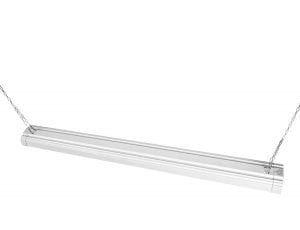 The technology these products use is state of the art LED lighting. You can get them in a pack of 10, or just order one piece for a small change to your garage.
The technology these products use is state of the art LED lighting. You can get them in a pack of 10, or just order one piece for a small change to your garage.
On the downside, the chain links are made from a pretty weak material.
Can you count on Linkable’s lamps as a heavy duty garage lighting fixture?
Our tests revealed the aforementioned weak chain links since we were able to break a few after hearing of this disadvantage. To add to the issue, our focus group reported the use of these panels will interfere with AM frequencies, so maybe consider a different product if you want to listen to your radio in the garage.
With that in mind, the experts we’ve talked to spoke in favor of this product, claiming they’re heavy duty, and our focus group was overall satisfied with it - there’s no doubt, these are good garage lighting systems.
Overall Qualitative technology
Very efficient, with 120 lumens produced for each watt
Weak chain links.
Interferes with AM radio frequencies.
Barrina’s LED lamps come in a pack of 6, bright fixtures, with 2200 lumens output, for the small consumption of 20W. This translates to 110 lumens per watt, a great deal it seems, but let’s take a closer look at these well-designed lightings, and see if they add up.
The bright lamps emit a 6500K white light, making it daylight in your shop at all times. As stated, for a 20W consumption, they output 2200 lumens, which is not as bright as some competitors.
They’re really easy to install, and they feature a lot of connecting cords that allow you to link the lamps together. Which in turns makes it easy to put any planned light layout in practice.
On the downside,
The heat they output is pretty large with that 6500K mark, making the product not really suited for a hot garage already. Moreover, we noticed that they are a bit noisy, but that’s probably a personal preference.
Any other info from our lab?
The people from our focus group also complained about the noise, stating it can get bothersome at times, but some of them reported getting accustomed to it. We guess this is just a matter of personal preference, but if you know unwanted ambient *crrr*-ing sets you off, maybe go for a different product.
To add to that, our experts claimed the temperature is a bit high. But if you use it for up to 3 hours a day, there should be no concern.
Other than those issues, we couldn’t find anything else wrong with the product, and overall it’s a choice to consider, as most of us, the people from our focus group, and experts advised.
Easy to install
Linkable
A bit too hot
Noisy
If you want to tweak your garage, the 1-pack or the 4-pack from HyperSelect might just be the choice for you. They’ve got a pretty good consumption, a large 49-inch size, and a cool steely finish.
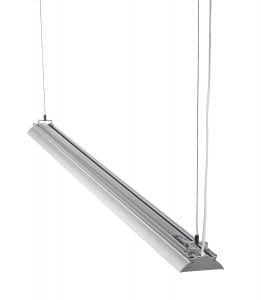 But is this good enough to be the best garage lighting system?
But is this good enough to be the best garage lighting system?
Let’s find out.
The 5000K temperature ensures a crystal white light, hitting the right spot our research discovered as the best for garage lighting systems. The 35 W consumption for the 3800 lumens output makes this fixture an efficient 108 lumens per watt.
Its size is pretty good as well, measuring 49-inches in length--some of the biggest on the market. The long hanging mount chain is helpful too, allowing for a wide variation of installation layouts.
On the downside, we’ve noticed they’re quite difficult to install, with a needlessly complicated hang system. And they’re not linkable.
Can this pack be the best garage lighting system?
Well, besides the problems outlined before, we also had troubles with the cord. Our focus group reported having problems installing this fixture the way they wanted because the plug-in cord is only 3 feet long.
Experts we’ve talked to generally favored this piece, but one of them said HyperSelect sometimes sends LED bulbs with a 4000K light temperature, instead of the marketed 5000K light. With all of that in mind, we generally had a fun time setting this system up, and the overall quality is not something to dismiss; it’s just that it needs some improvement.
LED system
Sturdy, large design
Difficult to install
Not linkable
Besides sounding like a sci-fi video game town, Hyperikon also produces high-quality LED garage lighting systems. Their products are bright, efficient and good looking, but let’s see if they “survive” Bestazy’s hands-on.
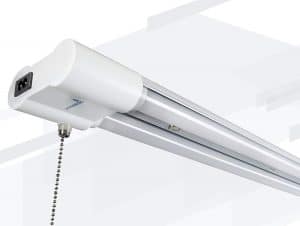 The lamps come in a 4-pack, or a 1-pack and they feature 4000K light temperature, not the hottest out there, but pleasant enough to feel at ease in your garage. With a consumption of 38 W, these lamps can output 4000 lumens, making it efficient enough to produce 105 lumens for each watt consumed.
The lamps come in a 4-pack, or a 1-pack and they feature 4000K light temperature, not the hottest out there, but pleasant enough to feel at ease in your garage. With a consumption of 38 W, these lamps can output 4000 lumens, making it efficient enough to produce 105 lumens for each watt consumed.
They have good numbers, but we also have to praise the aesthetic curvy design of the fixture, and they’re easy to install (as long as it’s not on a ceiling joist).
If we’re to talk downsides, the Hyperikon LED lamps are hard to install on a ceiling joist, and the rivets needed for set-up are poor quality.
How did the Hyperikon fare in our lab?
We had a pretty good time testing these out - they’re bright, plus, the color and design are appealing and pleasant to look at.
This stance was mirrored by our focus group members, yet experts complained about the aforementioned installation issues - hard to place on a ceiling joist and poor rivets.
To add insult to injury
An engineer we talked to stated that he used these lamps in the past and that they sometimes have issues turning on.
With all of that in mind, however, the products are overall qualitative.
Bright
Aesthetically pleasing
Hard to fix to a ceiling joist
Poor rivet quality
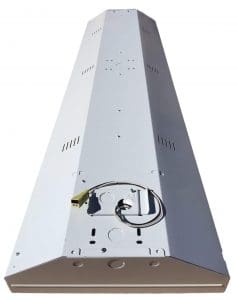 This huge system features 6 really bright tubes that come together to properly light anything. You’ll understand the 132 W consumption when you find out that this Stingray product outputs 17,000 lumens, way above market competitors. If you’re looking for brightness, this might be for you.
This huge system features 6 really bright tubes that come together to properly light anything. You’ll understand the 132 W consumption when you find out that this Stingray product outputs 17,000 lumens, way above market competitors. If you’re looking for brightness, this might be for you.
The Stingray 6 pack features a 5000K light temperature. Those 17,000 lumens output, corroborated with the 132 W consumption leave us with a very efficient 128 lumens for each watt, but the big numbers don’t stop here. The size of this piece is pretty enormous, measuring 48-inches long by 15-inches wide--bound to cover your lighting needs.
On the downside, the base materials are pretty cheap and the wiring comes out of one end, not the middle, so you’ll need to do some tweaking for a successful set-up.
Does it withstand testing?
The focus group and ourselves were left pretty satisfied with the product, yet the experts had a few words to say.
What’s the matter?
While overall the product will do the job, the base materials from which it is made are cheap alloys, prone to breaking. Moreover, the way the wiring protrudes is not the best. With all of that in mind, most of the people we consulted recommended the product.
One other thing we’d like to add is the brightness on this one is heavy duty, yet the dispersion of light will not allow you to illuminate a room bigger than 20 sq. feet with only one product. You’re going to need several if you want to go for the Stingray.
An efficient 128 lumens for each watt consumed
Heavy Duty in almost all intents and purposes
Poor base materials
Hard to set up due to faulty wiring protrusion.
With an attractive, multi-directional build, this TriLight lamp is perfect in the middle of your garage. It’s pretty bright, has a nice color, and a fairly good consumption, but does it has what it takes to be a worthy choice? Let’s see.
 The first thing we want to state about this motion-activated gem is the design. The multi-directional build helps illuminate all sides of your garage while looking pretty futuristic as well.
The first thing we want to state about this motion-activated gem is the design. The multi-directional build helps illuminate all sides of your garage while looking pretty futuristic as well.
The package is SGS certified, ensuring quality, and the lamps output 3000 lumens for a consumption of 60 W. Another benefit that we have to mention is the fact that the base materials are really qualitative.
On the downside, we can see a few people disappointed in the 3000-lumen output, saying it’s not that bright, but we weren’t discouraged by this right off the bat - we put the claim to the test.
What did the tests find?
Experts generally spoke in favor of the TriLight panel, many of them claiming however that the motion sensor is often faulty, and the fact that it’s not as bright as you may expect. While we and the people from our focus group encountered these problems as well, it was certainly not a bummer, and the product is really good nonetheless. It’s not the single best garage lighting out there, but it made it to the top 10.
Interesting & appealing design
Overall Qualitative & Efficient
Not as bright as you may expect
Faulty motion sensor
Imagine a plate full of light. Turn it upside down, and you’ll get this massively bright and very large Hyperikon Light Fixture, with motion sensor included.
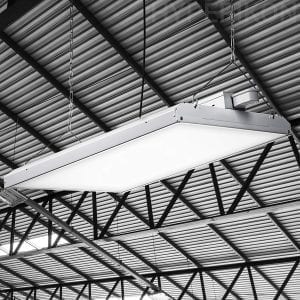 Sounds good, but can you count on it as a good garage lighting?
Sounds good, but can you count on it as a good garage lighting?
This Hyperikon massive lamp emits a light that measures 5000K in temperature. The other specs, however, are not that usual, with a consumption of 165 Watts that does go somewhere, specifically in the 22,000-lumen capacity, also amplified by the 23-inch long by 17-inch wide size.
How did the Hyperikon fare in our testing?
That 22,000-lumen output is an obvious change compared to other products.
This thing is really, really bright.
We weren’t surprised by this, but we certainly appreciated the near daylight feeling it provided in a spacious room.
Our focus-group also seemed to approve of the product, but, once again, the experts had a few things to say. First of all, dimming works pretty weak on the product, only being able to reduce about 10% of the brightness, and secondly, the light output is pretty directional, so you’re going to need more of these to be able to properly distribute their lighting.
Other than that, one last thing we’d like to mention is how clear and actionable the instructions are, making set-up a blast.
Really bright
Pretty efficient (133 lumens / watt)
Dimming doesn’t really work
Unidirectional light output
With an attractive design, a competitive low consumption, the Lithonia can make it as your garage lighting, even if it’s the last to be included on our list.
This big lamp with four tubes features a consumption of only 32 watts. That’s even lower than most traditional light bulbs on the market.
So what’s the catch?
Well granted, you’re only going to get about 2000 lumens out of it, which is lower than market competitors, but bright enough to properly light your garage.
The nice steel design is also something we loved, and one has to appreciate the 48-inch length, which makes it large enough to accommodate most needs.
A hands-on of the Lithonia
In our research, we discovered this lamp is heavy duty, being constructed out of sustainable base materials. The focus group seemed pretty satisfied with the Lithonia Shoplight, also appreciating the design, and the experts, while they were not hyped by it, at least spoke in favor of the lighting system.
However, we did notice a lot of people were shipped damaged products, much more than the usual complaints, and we hated how close together the bulb sockets were.
Moreover, while the base materials are qualitative, they’re flimsy put together, dragging the overall quality down.
A nice design
Low consumption
Bulb sockets are too close
The whole fixture is hastily and cheaply put together
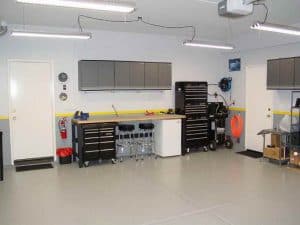 Every little detail we talk about here will be explained in the buyer’s guide, but just for reference, we reviewed products based on a few criteria. The first one is lumens and wattage. But they’re most important put together because lumens/wattage equals how much power the device will consume.
Every little detail we talk about here will be explained in the buyer’s guide, but just for reference, we reviewed products based on a few criteria. The first one is lumens and wattage. But they’re most important put together because lumens/wattage equals how much power the device will consume.
The higher the lumens per watt, the more efficient your lighting will be. Just for reference, the average light bulb out there consumes about 12-20 lumens per watt.
Lumens are also important to determine the brightness of your future light. And again, your average light bulb outputs about 500 -1000 lumens.
But there’s more to it than that…
We discovered this number can differ a lot based on brand, technology, and wiring.
The light color is also something that impacts brightness. It’s measured using the Kelvin, a measure of absolute temperature. Bulbs will vary in their temperature anywhere in between 1000 and 10000 K. But in our research, we discovered that most garage lighting is in the 4000-7000 K range.
Lastly, once we cleared through the technical details, we focused on secondary things in our research. We looked at other features and possible uses of the lights. But most importantly, we listened to the people. We scoured amazon reviews, used the products ourselves, organized a focus-group, and discussed with experts from a lot of fields.
These are the general stuff you should keep in mind, but if some things may still not be clear, we’ll explore every little detail below.
The official IESNA definition of a lumen is a bit complex:
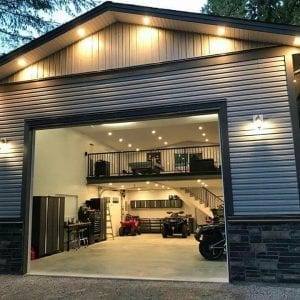 If that makes no sense, don’t worry, it didn’t to us either at the beginning.
If that makes no sense, don’t worry, it didn’t to us either at the beginning.
The translation of that definition is actually pretty easy. Lumens are these small things that make up the amount of light our naked eye can comprehend.
In essence, they are brightness – how much light we can see. More so, they’re measured from a source of light that emits radiation in every direction equally – a bulb, be it LED, LFD or traditional.
As we said, a regular bulb from your average house will output 490 lumens. But let’s have a little fun with this:
The number of lumens the sun outputs, estimated, is 98000. With that in mind, up close this type of brightness will ruin your eyes.

No one wants to burn their eyes out.
That’s why we put all the lighting options to the test for you. We discovered that the best garage lighting fixtures emit about 3000 – 6000 lumens.
The watt is a measure of power. We’re not talking, as you may realize, about any type of muscle power. Rather the watt measures the power of electrical devices.
What does that mean specifically?
Well, it’s a measure of how much energy is transferred per second, from a source of electricity to a consumer.
It may sound complicated, but it’s really easy to wrap your head around it. Think of it this way, the more watts a light has, the more power it has.
Well, lumens are not the only thing affecting the brightness. The higher the wattage of a light, the brighter the light it produces. It’s not a direct causation, but rather a correlation issue since more watts automatically means more lumens, which mean more brightness.
So how do these two come together? Well, a certain wattage (let’s say 40 watts) is generally able to produce a certain amount of lumens (generally about 490 lums for that wattage). But those are the numbers for a classic light bulb.
LED technology changes everything.
With LED technology being much more efficient. It’s actually a huge disparity since 40 watts powering LED bulbs can muster thousands of lumens, a drastic change in brightness.
Energy.gov does a great comparison of LED vs. incandescent lighting here.
Well, you can calculate the efficiency of a garage light by calculating the number of lumens produced for each watt, or lumen per watt. Your average bulb that we talked about, with simple calculus, produces 12.25 lumens per watt.
By comparison, LED bulbs (which are usually the bulbs used in the products we look at today), produce 100 lumens for each watt consumed, on average. Keep in mind, this can vary drastically–it’s just a point of reference.

The temperature of the light, as we’ve talked about, is measured in Kelvins. K is a unit of temperature measurement, defined so that absolute zero (where all life ceases to exist; almost -500 Fahrenheit) is 0 K, and it is an indicator of what color we’ll see the light as.
From 1000 to 3000 K we’ll see it as a shade of yellow, up until 5000K it’s all white, and over 5000K it gets to a bluish white. That’s a general rule, it gets more complicated the more you look at it. If you want to read more about light temperature, check this page; they also have a cool, self-explanatory light color chart.
Just an interesting fact:
The temperature of light at midday is anywhere between 5000 – 7000 K, depending on the weather, but there are a lot of bulbs out there that exceed that 7000K mark.
Most garage lighting fixtures will run around the 5000K mark, which ensures a bright white, maybe with a shade of blue from a certain angle.
That’s all fine and dandy, but what’s the best combo to have?
Well, from our tests we chalked up the, let’s say, goldilocks zone of garage lightings. The best structure of this type, according to our focus group and the handymen we interviewed, is a wattage of 45-70 Watts, over 3500 lumens produced from those watts, and a color around the 5000K mark.
However…
Keep in mind this is an average number. But you can still get extremely good results with drastically different structures. It all depends on how you’ll use these garage lighting fixtures.
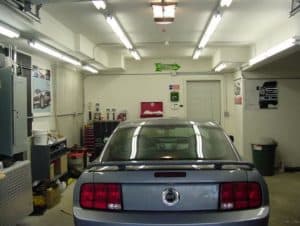 What’s your garage like?
What’s your garage like?While technical details are really important in making the best decision for you, they only account for half of the thinking process. The next thing you have to take into account is your garage and your activities in it.
There seems to be as many packaging options as there are garage lighting brands. You can get a pack of 4, a pack of 6, 8, 10, or even a cool one light with 3 multi-directional lamps. With that in mind, more of a financial advice would be to choose a pack with as little lamps as possible, but enough to satisfy your needs. A two car garage can be properly lit with only two, 3000 lumens lamps, maybe three to add one above your workbench. However, a big hall with 3 benches and a forge will require over ten such lamps.
If you really want to calculate everything to the dot, a 3000 lumens lamp will fully light, even in bad weather, 10 square feet of garage area, even up to 20 feet if you place it well.
On a different note, one last (almost) objective thing to consider is features. There are lamps that can be stuck together, lamps of different sizes, multi-directional lamps, and dozens of possible cords, wires, and uses. Technology evolves rapidly in this medium, and there’s bound to be a feature that you absolutely require.
For example, if you do both car repair and woodwork in your garage, you may appreciate the “stack-ability” of lights. During a car repair, you may need everything properly lit, but if you’re solely working on your bench, stacking the light sources next to each other for a concentrated burst of brightness on a specific spot may be desirable.
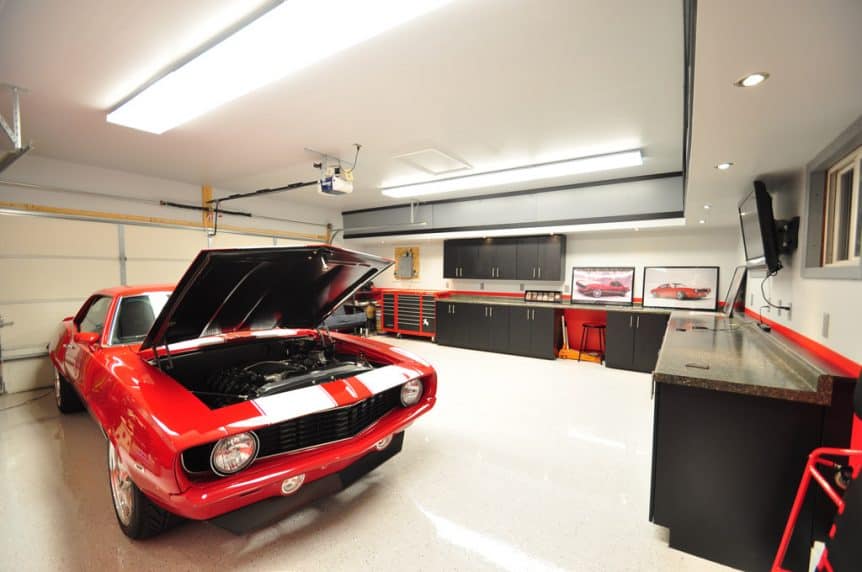
Lastly, you should take into account your personal preference. Yes, light temperature is favored by most if it’s over 5000K. People say that lumens over 4000 are bright enough to feel like daytime in the evening, but in the end, you should choose what you prefer.
There’s a lot of people out there who love the yellowish glow of the 2700K light, and for some sensitive people out there, 4000 lumens is too bright. Some people like a silver finish, others would go for a black coated lamp.
In the end, when the general, technical details are out of the way, and you know you won’t spend a fortune on the electricity bill, use the information in this article to make a decision tailored to your needs & preferences.
Voltage
I know what you’re thinking.
“Ugh, more physics…”
But it’s important to get some things out of the way to ensure a proper use of garage lighting systems. By definition, voltage is an electromotive force or potential difference expressed in volts; again, if that doesn’t make sense, we’re here to help.
Put simply,
Think about your garage lighting electrical circuit as a pipe. In that case, the voltage would be the pressure of the water passing through it.
Now, although many of us would not be careless enough to put a 110 V appliance into a 220 V socket, with the smaller voltage of garage lighting fixtures, people seem to be more at ease with using incompatible products.
Don’t be misled by the apparent consequence-free situation; although your 12V appliance will not burn out immediately in a 24 V socket, the wear and tear of the product long-term is significantly increased, so make sure you use compatible appliance and socket.
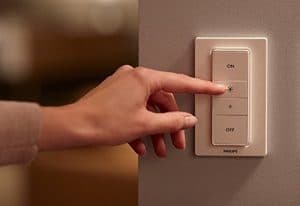
What this is, basically, is using a special device to lower the brightness of your light, making it dimmer. And in most cases, this will be installed somewhere in the back of your lighting fixture, with only a small switch visible to control the brightness of your lamp. People generally do this to save on energy usage, running that electricity bill down, but let’s take a closer look at this practice and see if it actually works, and what the ups and downs are.
Engineers we talked to generally agreed this is a functional practice, with some of them actually having done this in the past, reporting satisfactory results.
So, it does work.
But what are the pragmatic results?
Will you actually save that much?
Well, the math depends a lot on how big your house is, how much you use the dimmer, etc, but generally, for a $110 electricity bill (the average in the US), experts say it can be slashed down to $80-90.
With that in mind, remember this: If you plan on using the dimmer non-stop, you’re much better off buying a garage lighting system that simply consumes fewer watts, and is automatically dimmer.
Yes, it’s an eco-friendly (even cool in movies) way to save on energy, but only if done in moderation, because over-using this piece of technology may end up costing more.
One last mention about dimming, before we move further, is installing them. Nowadays, dimmers have developed a lot, and some of them come with installing instructions and all the nuts and bolts you may need.
Beware,
This is a bit more complex piece of technology than a simple light bulb. A poor installation may lead to a poorly-controlled flux of energy, which in turn may lead to heavier wear & tear of your lamps, and even burning out in some cases.
If you’re not confident with electrical circuits and how they’re altered, we suggest you call an expert electrician to do it for you.
Since we touched on that, let’s get something else out of the way.
The way you technically set up your lighting system (actually connect the wires and cords) is not that complicated in most cases, and almost every fixture will come with an instruction manual to help out.
If you want to get an idea of what you’ll have to do, however, you can take a look at this video. Tyler G here sets up a pretty complex system, which requires some work, but in general, you’re going to have to do less than he does.
However, this Youtuber touches on a pretty interesting topic, which is strategically planning the layout of your lighting fixture. Physics can get complicated sometimes, and actually calculating the most efficient way to plan the layout of your lighting (which lamp goes where, why, etc) can get tedious, but the layout Tyler uses is pretty efficient, and you can go with that.
With that in mind,
If you want to study more about lamp layouts and the best ways to plan which bulb goes where for the brightest experience, you can check this video out. It’s only 3 minutes long, but graphically details some of the most creative layouts, and it’s a good place to start learning about this.
The last thing I want to get out of the way is some industry norms and general standardization issues for lighting.
You’re going to read a lot of acronyms in garage lighting product descriptions, and some of these may actually be important, and signal some crucial facts about your possible purchase.
It could seem benign, but lighting technology is so developed (and so impactful on your bills) that a mention of the UL listing means a lot.
If you can’t see a certain product bragging about a certification, you can just scroll down to the detailed specs, and read about the standard they followed when making the product, under the “Certification” row.
Sometimes,
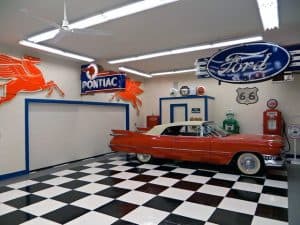 You’ll see products listed on Amazon will not have this row down at the detailed specs, and this can be because of two reasons. One, the marketing team that created the product page forgot to include it (shame on them, for people like you that know a lot about certification, any info of this sort is important), or two, the product is not certified in any way.
You’ll see products listed on Amazon will not have this row down at the detailed specs, and this can be because of two reasons. One, the marketing team that created the product page forgot to include it (shame on them, for people like you that know a lot about certification, any info of this sort is important), or two, the product is not certified in any way.
In that latter case, it doesn’t necessarily mean the product is bad, but you can certainly trust a certified product more. It’s been proven by an objective third party that it’s good. Knowing all of this, you can think of certification like a recommendation letter from someone with decades of experience in the industry.
UL Listing
The biggest player in the standardization market is the UL. They’re a global company, with headquarters in 46 states and feature some cool norms. UL certified products have to be sustainable, which means they’re as eco-friendly as possible.
It gets better,
They also have regulations about what’s allowed or prohibited in marketing and advertising, to ensure no manipulation tactics are employed, and they make sure the best, longest lasting materials are used in their certified products. The company has a long history in certification, and they’re also a cool enterprise – they are always evolving, allowing academics and engineers to submit proposals for new standards or modifications to older standards.
Products listed at the UL will have a small mark like this on the packaging, and you’re bound to find quality in such products.
SGS
Another big name in the certification business is SGS. They’re also a huge company, but they deal with many more standards, far from a single market. They focus on upholding regulations in agriculture, health & safety, or even art & culture.
What we’re concerned about today, is their dedication to industry norms in the energy department, garage lighting falling under this category. While they do fight for some norms in terms of materials being used, they’re much more concerned with the sustainability side of the issue, making sure workers are safe at all stages of production, the process of production is eco-friendly, and that the final product is as energy-saving as possible to protect the environment. Their mark looks something like this.
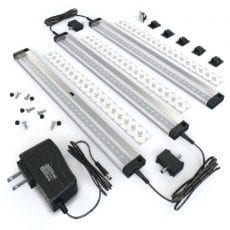
Don’t get left in the dark. Brighten up your workspace with the best garage lighting setups we could find. The search for perfect lighting ends here.
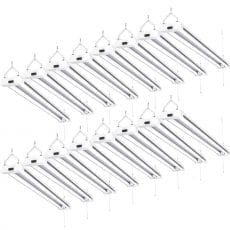
Don’t get left in the dark. Brighten up your workspace with the best garage lighting setups we could find. The search for perfect lighting ends here.
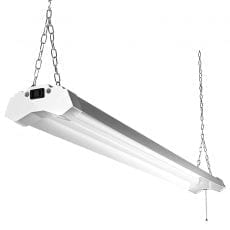
Don’t get left in the dark. Brighten up your workspace with the best garage lighting setups we could find. The search for perfect lighting ends here.
Well, intuitively you may think that such bright lamps will consume more electricity, and in turn get that bill a few dozen bucks higher. While this may be true in a specific case, say if you had two 40W bulbs in your garage, and replace them with 12 bright lamps, generally, you will end up paying less. This is because LED or LFD technologies, the ones found in garage lighting systems, are much more efficient; they output way more lumens for a fraction of the consumed energy.
The short answer is, it doesn’t matter. You should just look to buy something compatible with your already existing sockets, or the availability of your household electric wiring. With that in mind, the longer answer is that it depends a lot on your overall energy consumption, how much amps you want to use, and many other technical details.
The efficient technology. While you can get a few bulbs strong enough to light your entire garage for under $50, in the long run, the more expensive fixtures will serve you much better.
All of the products we included in this article, as well as what you’re generally going to find on the web, use advanced technology to consume less energy, allowing you to pay less and protect the environment at the same time. Moreover, the systems explored in this article are better-looking and much brighter than your regular bulb.

“Standard International (SI) unit of luminous flux. Radiometrically, it is determined by the radiant power. Photometrically, it is the luminous flux emitted within a unit solid angle (one steradian) by a point source having a uniform luminous intensity of one candela. The lumen is the time rate flow of light.”